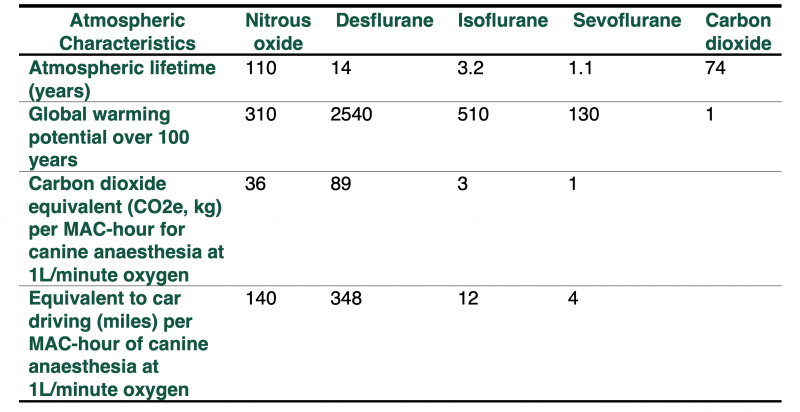It’s time to say ‘No’ to N2O
Nicole Dyer, Greener Veterinary Practice Working Group
Nitrous oxide is a gaseous anaesthetic traditionally used alongside other anaesthetic agents as an adjunctive analgesia. It is, along with other inhalant anaesthetic gases, a potent greenhouse gas, so therefore calls amongst human anaesthetists to reduce its use in healthcare1 and even the demand to eliminate its use completely by veterinary anaesthetists2.
There is now little scientific doubt that climate change is being driven by the anthropomorphic production of greenhouse gases, the most notable being carbon dioxide. Greenhouse gas accumulation within the atmosphere leads to less radiation being reflected from earth back into space and instead it being absorbed by greenhouse gases and reemitted as energy towards earth causing a general warming effect. Whilst carbon dioxide is the most talked about player in this effect, it is not alone. The main greenhouse gases that are outlined and monitored by the Intergovernmental Panel on Climate Change (IPPC) are carbon dioxide, methane, nitrous oxide and halocarbons3. Whilst not formally monitored, it is worth noting that anaesthetic gases such as isoflurane and sevoflurane also act as greenhouse gases and come under the category of fluorocarbons.
Not all greenhouse gases are equal - their effect depends on what frequency and amount of radiation they reflect and their persistence within the atmosphere. This difference in effect is compared by using the global warming potential (GWP) over 100 years with carbon dioxide often being used as a standard of 1. Carbon dioxide equivalency (CO2e) is a quantity that describes the amount of CO2 that would have the same GWP over 100 years.

Table 1: Atmospheric characteristic of anaesthetic agents reproduced from Jones and West 2019
Table 1 illustrates the GWP and CO2e for common anaesthetic agent used within the UK. The longevity of nitrous oxide within the atmosphere gives it a much higher CO2e than the other inhalant anaesthetics available, except for desflurane which is not routinely used in veterinary anaesthesia. This is why despite being present in the atmosphere in smaller quantities, anaesthetic gases are disproportionately effective as greenhouse gases compared to CO2. In addition to its greenhouse effect, another environmental consideration about nitrous oxide is that it has a damaging effect on the ozone layer. Ozone depletion leads to more damaging solar radiation and ultraviolet light being emitted to earth rather than reflected. In addition, prolonged exposures to nitrous oxide also have a negative effect on human health.
It is important to note that anaesthesia is not the only, or even the largest, source of global emissions of nitrous oxide - the majority of nitrous oxide emissions originate from agriculture4. However, given that we have many alternative analgesia protocols that can be used within veterinary anaesthesia its environmental impact outweighs its clinical benefit and importance and therefore it is hard to justify its ongoing use.
Phasing out nitrous – where do I start?
The first question to answer would be - during what procedures is nitrous oxide currently being used and why? What other anaesthetic agents are being used alongside it currently? Once this is known you then can start to identify what alternative protocols could be used to replace the analgesia effect that nitrous oxide has within these procedures.
Alternatives to consider implementing include:
- Pre-medications
- Using full mu agonist opiates like methadone provides better analgesia as part of our premedication.
- Where clinically appropriate incorporating alpha 2 agonists into a premedication can have a dose sparing effect on other anaesthetic agents being used.
- Adjunctive analgesia:
- Other forms of agents can be administered perioperatively if additional analgesia is required to stabilise an anaesthetic either as single administrations/bolus or continuous rate infusions.
- Ketamine, lidocaine and fentanyl are examples of medication that can be used in this way to assist in providing perioperative analgesia.
- Local Anaesthesia:
- Local nerve blocks and other regional anaesthesia techniques will reduce response to noxious stimuli and can have a dose sparing effect on other agents being used.
As well as facilitating the reduction of nitrous oxide use, such techniques can also facilitate reducing isoflurane/ sevoflurane needs during procedures and generally increase our patient comfort post operatively – that’s a win-win I’d say!
Other top tips:
- Communication with the team is imperative whenever considering a change in protocol and behaviours. We must listen to team members concerns about a change, have clear steps in place to monitor whether our change is being successful and be able to provide training in any areas where team members are not confident.
- It is worth keeping nitrous available during the transition period so that colleagues know it is still there if they need to fall back on what they know.
- Changing something as important as anaesthesia protocols can be daunting. For assistance consider reaching out to a specialist practice in your area as they are likely to be more than happy to offer what assistance and advice they can.
References
- Centre for Sustainable Healthcare, The Nitrous Oxide Project, available at: https://sustainablehealthcare.org.uk/what-we-do/sustainable-specialties/anaesthetics/nitrous-oxide-project (accessed 17/09/2022)
- Jones, R.S. and West, E., 2019. Environmental sustainability in veterinary anaesthesia. Veterinary Anaesthesia and Analgesia, 46(4), pp.409-420.
- Watson, R.T., Rodhe H., Oeschager H., Siegenthaler U., Greenhouse Gases and Aerosols https://www.ipcc.ch/report/ar1/wg1/greenhouse-gases-and-aerosols/
- United States Environmental Protection Agency, Overview of Greenhouse Gases, available at: https://www.epa.gov/ghgemissio... (accessed 21/10/22)